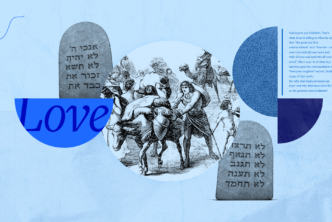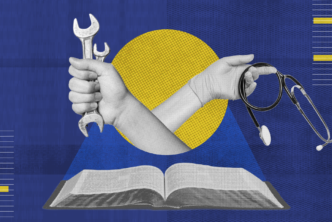In The Lord and His Prayer, N. T. Wright discusses the Lord’s Prayer phrase by phrase to show how understanding the original setting of the Lord’s Prayer can rekindle your own prayer life.
Here are six insights from Wright’s historical study of the Lord’s Prayer:
Jesus truly embodied the role of Son to God the Father.
“In John’s gospel Jesus uses the image of father and son to explain what he was himself doing. In that culture, the son is apprenticed to the father. He learns his trade by watching what the father is doing. When he runs into a problem, he checks back to see how his father tackles it. That’s what Jesus is doing in Gethsemane, when everything suddenly goes dark on him. Father, is this the way? Is this really the right path? Do I really have to drink this cup?”
Whether you have a good relationship with your father or not, Jesus’ actions provide the perfect example of how a child should relate to God the Father; as an apprentice to the master craftsman.
The kingdom is comprised of three parts.
Dr. Wright points out that the phrase, “thy kingdom come” takes its roots from the Old Testament prophet, Isaiah.
“Jesus took the three parts of Isaiah’s kingdom-message and set about implementing them. Release for captive Israel; the defeat of evil; and the return of YHWH to Zion.”
These three elements would have been incredibly significant for national Israel. But this also highlights the importance of the Old Testament to Jesus. It was the Old Testament that foreshadowed his arrival. It was the Old Testament that he taught from. And it was the Old Testament that he himself fulfilled.
Our needs are important, but not the sole purpose of prayer.
“We come to prayer, aware of urgent needs, or at least wants. It’s tempting to race through the Lord’s Prayer, as far as ‘on earth as it is in heaven’, so that we can then take a deep breath and say ‘Now look here: when it comes to daily bread, there are some things I simply must have. And then off we go into a shopping list. To do this, of course, is to let greed get in the way of grace.’”
Forgiveness is essential to life in the Lord’s kingdom.
The Lord’s Prayer is not a buffet where we pick and choose individual elements that appeal to us.
“Failure to forgive one another wasn’t a matter of failing to live up to a new bit of moral teaching. It was cutting off the branch you were sitting on.”
Each element is essential to a life in Jesus’ kingdom economy.
Evil and darkness followed Jesus from beginning to end.
As Wright points out, “The imagery of Christmas Eve, such as hasn’t been obliterated in our world by frantic preparations for the next day, properly includes the sense of the deep darkness before dawn, darkness before the Morning Star rises.” And yet, while Jesus was the light of the world, the light indeed shone in darkness (John 1:5). So, when Jesus reached the culminating point of his earthly ministry, we see him again, facing the darkness with prayer:
“In Gethsemane, Jesus shrank from drinking the cup held out to him. But he turned that shrinking into agonised prayer, until finally he stretched out his hands, in obedience, to take the poisoned chalice. ‘Behold, the handmaid of the Lord’—and, now, behold her son. This is what obedience looks like when it stares evil in the face.”
The concluding portion of the prayer, though not found in the earliest manuscripts, must have been part of the original prayer.
“This concluding doxology doesn’t appear in the best manuscripts of either Matthew or Luke, and it is only comparatively recently, in the last few centuries, that it has been restored to the liturgy of the Western church. But it was already well established within a century or so of Jesus’ day; and it is actually inconceivable, within the Jewish praying styles of his day, that Jesus would have intended the prayer to stop simply with ‘deliver us from evil’. Something like this must have been intended from the beginning.”
* * *
Discover more insights like these. Get The Lord and His Prayer today!






